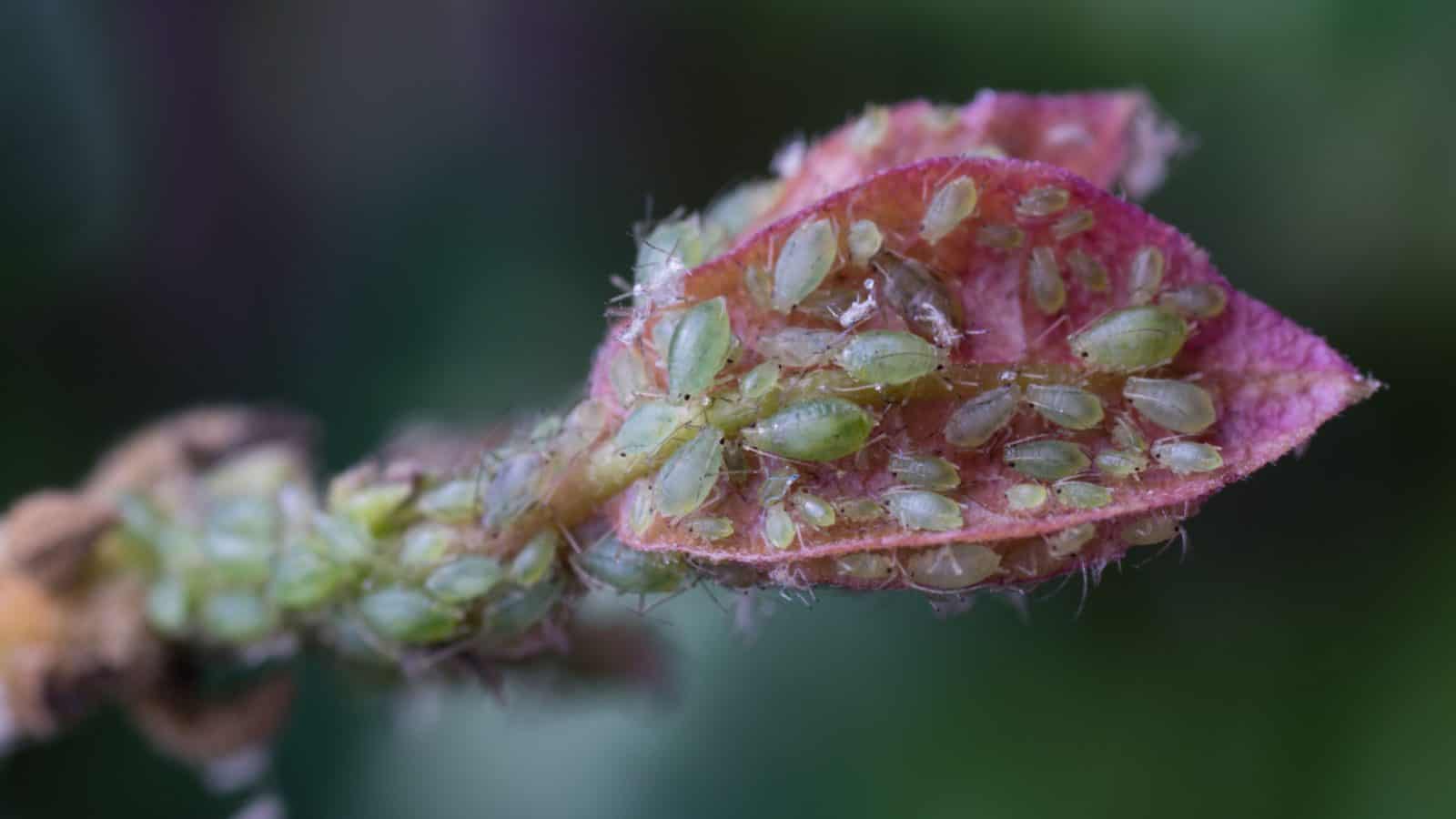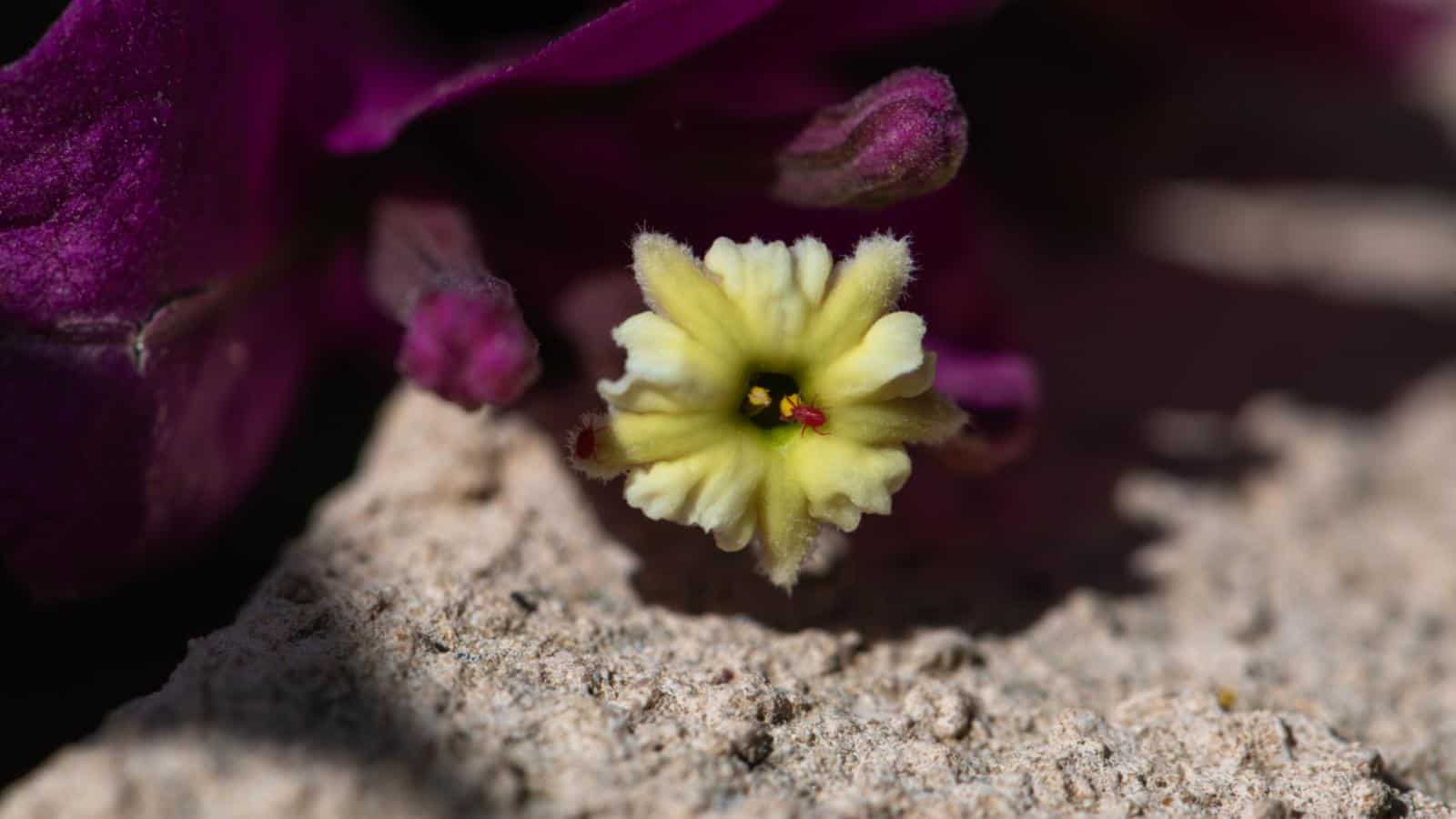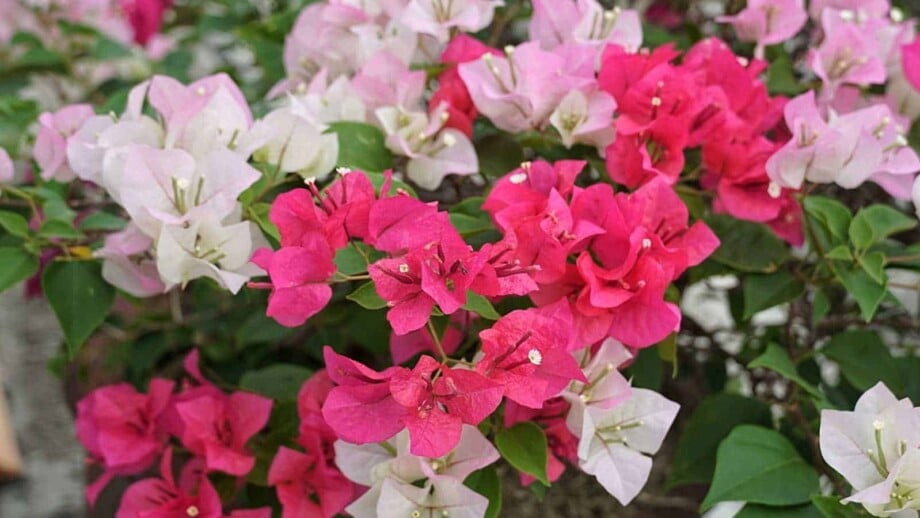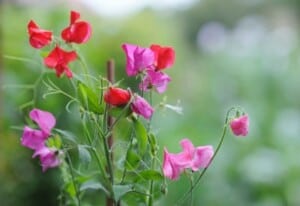From the vibrant cities of South America to the sunny backyards of South Florida, the Bougainvillea plant adds a vivid splash of color to any landscape.
This perennial vine, belonging to the Nyctaginaceae family and the Bougainvillea genus, is known for its robust growth and vibrant pink bracts that many people mistake as blooms. In reality, the colorful bracts surround the bougainvillea’s actual flowers, which are much smaller and less conspicuous.
Famous for its year-round, brilliant blooms, the bougainvillea vine is a beloved resident of climates favoring sunshine. This tropical plant thrives in full sun, vindicating its roots in the climates of South America. Its fondness for the sun makes it a popular choice in warmer regions, where it often adorns fences, trellises, and walls as a climber or groundcover.
Yet, the beautiful bougainvillea is not just all about aesthetics. It’s a hardy plant with a high tolerance for droughts, making it a pragmatic choice for ground covering in areas with drier climates.
Moreover, these durable vines are armed with sharp thorns that not only serve as a natural defense against pests but also make gloves a necessity when tending to the plant.
The Bougainvillea plant is just as versatile as it is vibrant. It can be grown in hanging baskets, large pots, or as bonsai, providing a stunning visual regardless of its setting. The only requirement is well-draining soil and plenty of sunlight to ensure its new growth and maintain its iconic, vibrant foliage.
As a master gardener, I’ve grown bougainvillea myself and helped countless other gardeners over the years. So, in this article, I’ll go over everything you need to know to grow and care for bougainvillea vine.

Botanical Name: Bougainvillea
Common Name: Bougainvillea, paper flower
Family: Nyctaginaceae
Plant Type: Vine, shrub, perennial
Hardiness Zones: 9 – 11 (USDA)
Sun Exposure: Full sun
Soil Type: Well-draining soil
Soil pH: 5.5 – 6.0
Bloom Time: Year-round in tropical climates, During warm months in cooler climates
Flower Color: Pink, Red, Yellow, Orange, White (These are the colorful bracts, not the actual flowers)
Native Area: South America
Bougainvillea Plant Care
Bougainvillea plant is a sun-loving perennial climber originating from South America, particularly appreciated for its vibrant bougainvillea blooms.
Thriving in full sun and climates similar to its tropical roots, like south Florida, they are climbers with sharp thorns so keep your gloves handy. When it comes to soil, opt for well-draining types, as too much water can lead to fewer flowers. A good option is to use compost for nutritious ground covering and aid drainage.
Growing them in pots, hanging baskets, or as a bonsai allows for manageable growth and ease in protecting against pests like aphids and spider mites which may threaten the plant.

Situate them along a sturdy trellis or fence where the vine can freely grow and you are likely to witness a parade of colorful bracts year-round, note these are not the actual flowers, this genus’s true flowers are the small white ones surrounded by the vibrant bracts.
Regular trimming encourages new growth, helps shape the shrub and fosters thicker foliage, making this diverse plant a valuable addition to any garden.
Light
Bougainvillea plants are tropical plants native to South America, especially at home in climates like south Florida, These climbers relish in full sun, which encourages the most new growth and promotes vibrant bougainvillea blooms.
To fully appreciate the colourful bracts, the actual flowers of the plant, we recommend placing your bougainvillea vine in an area that receives at least six hours of direct sunlight each day.

Shaded locations can host this perennial too, but expect fewer flowers and less colourful foliage. Whether you’re growing them as ground covering, in pots, or in hanging baskets, ensure they receive ample sunshine.
Soil
For efficient growth, bougainvillea requires well-draining soil with good drainage capabilities. These tropical plants, native to South America, thrive in environments where excess water doesn’t sit in their roots, thus reducing the risk of root rot.
Adding compost to the soil further enhances its draining capability whilst providing the necessary nutrients for plant growth. Whether potted as a bonsai or ground covering in a garden, ensure your bougainvillea is planted in a soil mix that is rich but not too heavy.
Another tip I’d love to share with you as a seasoned master gardener is to slightly acidify the soil for bougainvillea, as they thrive best in soil pH levels of 5.5 to 6.0.
Moreover, if you’re considering growing them in pots, make sure there are enough drainage holes at the bottom.

Water
Bougainvillea plants, native to South America, have evolved to thrive in various climates, including periods of droughts, making them quite resilient and less reliant on much water. They require good drainage, so they should be planted in well-draining soil, especially when grown in pots or hanging baskets.
Overwatering can lead to fewer flowers and new growth and make the plant susceptible to pests such as aphids and spider mites. In its natural habitat, the plant prefers a regular watering schedule but can withstand periods of limited water.
However, under-watering can lead to wilted foliage, so a balanced watering approach is best. In effect, while the bougainvillea plant can tolerate drought, it prefers regular watering to maintain its vibrant blooms and bracts.

Temperature and Humidity
Originating from South America, the bougainvillea plant is a tropical plant that thrives in climates with high temperatures and moderate to high humidity. This perennial vine adores the full sun and can effectively withstand prolonged periods of droughts making it an excellent choice for regions with hot, dry summers.
This genus of vine can handle temperatures down to about 30 F, but for year-round outdoor growth, regions like South Florida, with its above-freezing winter temperatures, are ideal.
However, as climbers, they can also be grown in pots or hanging baskets indoors if the climate is not supportive and temperature is kept above 60 F at all times.
Ensure a good indoor humidity level to provide a conducive environment for your bougainvillea vine, as too low humidity may slow down its growth.

Fertilizer
Bougainvillea plants are remarkable climbers native to South America, featuring bright and colorful bracts.
These tropical plants do not demand much from fertilizers, instead, they primarily thrive in well-draining soil enriched with compost. A well-balanced fertilizer applied in early spring promotes new growth and results in more plentiful bougainvillea blooms.
During the growing season, a monthly dose of a half-strength, water-soluble fertilizer will suffice, but in climates with year-round warmth like South Florida, this could be adjusted to every two to three weeks.
Over-fertilizing can lead to fewer flowers, as the plant may focus more on foliage growth, so a careful balance must be maintained.

Pruning
Pruning is a vital portion of bougainvillea plant care that encourages new growth for better blooms. As climbers, these vine-like shrubs can be trained upwards on trellises or downward as a groundcover, but to keep them in their best form, a good trim is needed.
While pruning, it’s advisable to wear gloves due to the plant’s sharp thorns. You should aim to remove dead or diseased foliage, shaping the plant in early spring or after its vibrant, colorful bracts have faded.
Always leave some leaves on the vine to not starve the plant and encourage fewer flowers. Pruning helps to promote good drainage, vital for the health of this tropical plant.

Overwintering
The durable bougainvillea plant manages to withstand droughts in its tropical climates but it does require special care during winter, especially in regions unlike its native South Florida. These hardy vines, adorned with colorful bracts around their actual flowers, can sometimes lose their leaves during colder months.
To facilitate new growth during spring, ensure the shrub is in a well-draining soil or pot and minimize the watering as these plants do not require much water during their dormant phase.
However, beware of pest-carrying aphids and spider mites which might infest the leafless plant. To overwinter the plant indoors, use good drainage pots or hanging baskets, prune it to a manageable size and keep it in a bright, cool location.
If you live in a warmer climate, you can leave it outdoors and use it as a perennial ground cover or fence climber on trellises, but take caution to water it sparingly to avoid inducing a state of survival rather than dormancy which could result in fewer flowers in the subsequent blooming year.

Types of Bougainvillea
Barbara Karst: This is a popular variant of the bougainvillea plant. This climber tends to establish itself readily on fences and trellises, producing vast blooms of vibrant pink bracts.

California Gold: This perennial produces golden blooms that stand out against a fence or ground covering. The vine of California Gold bougainvillea is sturdy and rich in foliage, making it an excellent option for pots, hanging baskets, or trellises.

Miss Alice: This is a lovely bougainvillea, adorned with white flowers and sporting sharp thorns. Its unique bracts are a brilliant pure white and tend to catch the eye.

Sundown Orange: This type of Bougainvillea is praised for its stunning orange blooms—colorful bracts that and add a tropical touch.

Purple Queen: This variety is treasured for its deep purple blooms which brighten up trellises and hanging baskets beautifully.

How to Plant Bougainvillea From Seed
Soil Preparation
Prepare a well-draining soil mix in your pots or hanging baskets. This can be achieved with a combination of standard potting compost mixed with added grit or perlite to enhance drainage.
Bougainvillea thrives in full sun and in climates that provide good drainage, much like the drought-ridden regions they evolved in.
Planting the Seeds
Plant your seeds shallowly as Bougainvillea is usually a ground covering or a climber. Cover the seed lightly with compost, no deeper than 1/8 inch.
This is because it is a perennial plant that will repeatedly produce new growth year-round, however, the seeds must not be smothered or they will not germinate.
Caring for Bougainvillea Seedlings
The next step is ensuring that the seedlings have continual access to bright but indirect sunlight. Be careful not to provide too much water, they prefer conditions on the drier side.

If the bougainvillea receives too much water or too much shade, it results in fewer flowers. Ensure the soil is kept moist, but not waterlogged.
Pruning and Trellising
After your bougainvillea plant starts growing sturdily, install trellises or plant near a fence to encourage the vine to climb. You can also consider growing it as a bonsai for a more controlled aesthetic.
An early pruning has the effect of encouraging more branching, leading to a fuller shrub. Always use well-fitted gloves while pruning due to the sharp thorns on the plant.
How to Propagate Bougainvillea
1. Select a Healthy Bougainvillea Plant
Start by selecting a healthy bougainvillea plant which exhibits vibrant bougainvillea blooms and shows no signs of pests, like aphids and spider mites.
2. Choose the Right Time
While bougainvillea blooms year-round in climates like south Florida, the best time to take cuttings for propagation is early spring when the plant is experiencing new growth.
Its growth slows during the winter, and propagating during this time may result in fewer flowers. Even in full sun, success rates will be higher if you catch the vine in its active growth stage.
3. Prepare your Pot
Prepare a pot or hanging basket with well-draining soil for the new plant.
Good drainage is vital for bougainvillea as this plant prefers to dry out between waterings. Ensure your chosen container has a suitable drainage hole.
For an added boost, mix some compost into the soil; it will provide essential nutrients promoting healthy growth.
4. Take Cuttings
Wear thick gloves to protect your hands from the plant’s thorns. Cut several pieces of new growth off the bougainvillea. Each cutting should be about 4-5 inches long.
Avoid taking cuttings from blooming stems as this draws energy away from rooting, therefore making sure your stems have foliage but not actual flowers.
5. Plant the Cuttings

Remove any leaves near the base of your bougainvillea cuttings. Insert the cuttings into the soil, pressing it lightly around the stem.
Water the cuttings using only enough water to keep the soil moist but not oversaturated. Bougainvillea thrives in drier conditions, and too much water can lead to root rot.
6. Care For Your New Bougainvillea
Initially, you may want to provide some shade for your cuttings, transitioning to full sun as the plant establishes.
Water only when the soil begins to dry out – remember, bougainvilleas, whilst being adaptable to different climates, are essentially drought-loving plants. In a few weeks, if cared for correctly, you should notice new growth on your cuttings.
7. Train Your Bougainvillea
Once your cuttings have started to grow, you can begin training them to grow on trellises or as a ground covering.

Bougainvillea is a versatile climber, and with the right guidance, it can be trained to grow as a shrub, groundcover, or trained as a bonsai. In addition to trellises, you might consider using a fence or other structure for support.
Through this process, you can watch your bougainvillea vine transform into a spectacular display of bright bracts. With its year-round blooms and striking appearance, your propagated bougainvillea is sure to catch anyone’s eye.
How to Pot or Repot Bougainvillea
Step 1: Choosing the Right Pot and Soil
When choosing a pot for your Bougainvillea, ensure it has good drainage, as these vines require well-draining soil to thrive. Many gardeners prefer a clay pot as it allows for better evaporation of excess water.
The Bougainvillea is a native of South America, and as such, it has evolved to prosper in relatively arid climates and to withstand droughts. F
illing the pot with a mix of loamy soil and compost will provide the necessary nutrients while ensuring efficient water drainage.
Step 2: Handling the Plant Carefully
Handling the Bougainvillea plant requires caution due to its sharp thorns – a pair of protective gloves is highly recommended for this task. The Bougainvillea is a climbing shrub that’s often seen scaling trellises and fences in warmer climates.
If you are dealing with an established plant, ensure you are careful with its tender new growth which may not yet have developed the characteristic hardiness of mature Bougainvillea foliage.
Step 3: Transferring and Pruning the Plant

Before transferring the vine to its new pot, prune back any dead or diseased sections – this supports healthy new growth and better blooms.
The Bougainvillea plant is a climber by nature, therefore trellises can be used to direct its growth.
If your goal is to encourage the plant to grow as a groundcover, laying a vine in the direction you want it to grow and securing it gently in place will help guide it.
Step 4: Care for the Transplanted Plant
After potting, avoid the temptation to overwater the newly potted Bougainvillea. Too much water will lead to a lush plant with fewer flowers, as the plant will prioritize producing foliage over blooms.
Instead, water sparingly, allowing the top layer of soil to dry before watering again. This strategy imitates the natural drought-like conditions that the Bougainvillea genus is accustomed to in its native tropical habitat.
Common Pests and Plant Diseases for Bougainvillea
The beautiful bougainvillea plant, native to South America, is a perennial shrub that can transform into a vine with the right trellises and training. Despite its exotic and colorful appearance, this plant can be prone to various pests and diseases that may harm its vibrant foliage and blooms. Here are a few common issues to keep an eye out for:
Aphids

These tiny pests can cause damage to new growth, leading to misshapen or yellowed leaves. Aphids typically appear during the spring season and are often located on the underside of leaves. Regular inspection and use of an appropriate insecticide can help control these pests.
Spider Mites

Spider mites are small pests that puncture plant cells to feed, often resulting in speckled or brown leaves. They thrive in hot conditions and usually infest bougainvillea during extended periods of drought. These pests can be kept at bay with regular misting of the foliage and proper application of miticides.
Diseases
Bougainvillea plants are susceptible to a variety of fungal diseases. Root rots can occur when sitting in waterlogged soil, emphasizing the need for good drainage in pots or ground coverings.
On the other hand, leaf spot diseases can create unsightly brown or black spots on leaves, but can be managed with appropriate fungicides and by avoiding overhead watering which leaves foliage wet for extended periods.
Investing time in understanding and implementing preventive measures can aid in maintaining the health of your Bougainaiilea, ensuring its vibrant pink blooms and sharp thorns are a constant, year-round feature in your garden.
Common Plant Problems and Solutions for Bougainvillea
Brown Tips
Brown tips on Bougainvillea plant often suggest that the plant is lacking in required nutrients or adequate amounts of water. They normally do well in a well-draining soil mix that contains compost to provide nutrients.
As they are perennial climber vines native to South America, where droughts are common, they don’t need much water. However, new growth may suffer if the plant is too dry for a long period especially when in pots or hanging baskets.
Yellowing Leaves

Yellowing leaves can indicate a pest problem or incorrect light exposure. Vine pests, like aphids and spider mites, can lead to yellowing leaves. In this case, wearing gloves due to the presence of sharp thorns, remove infected foliage and treat the plant with a suitable pesticide.
Furthermore, since these tropical plants thrive in climates with full sun, ensure they get sufficient sunlight. If situated in a shade-heavy area, consider transferring to a place that gets 6-8 hours of sunlight.
Insufficient Blooms
Bougainvillea blooms year-round, especially in warm climates like South Florida, producing a riot of colorful bracts, which are often mistaken for true flowers. The actual flowers are small and white, surrounded by the vivid bracts.
If you notice fewer flowers, it might be due to insufficient light or overwatering. Sitting them in full sun will lead to the best display of foliage. Additionally, ensuring good drainage can reduce root rot risk leading to a healthier plant and more blooms.
Non-Climbing Bougainvillea
Bougainvilleas are climbers and can be trained on trellises or used as groundcover or even maintain as a bonsai. If the Bougainvillea Vine fails to climb a fence or a trellis, it might be due to low light conditions or an unsuitable growing environment.
Move the plant to a place with better light and train the new growth along the trellis or fence. Alternatively, consider repotting if the plant is a potted Bougainvillea.
Remember, a healthy Bougainvillea begins with understanding its native environment and requirements. Always mimic these as closely as possible and consult with a master gardener or extension service if problems persist.
Other Flower Guides from Planet Natural:
68 Types of Pink Flowers (With Pictures and Plant Care Tips)











